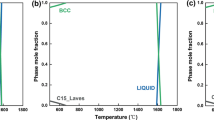Abstract
Three commercially available carbon-graphite cryogenic materials(EC-5, M234 and P5N) that are used as seals in rocket turbopumpassemblies have been characterized as part of a larger study toelucidate their tribological characteristics in helium andhydrogen. This report (part I) documents the results ofstructural/chemical characterization that included XRD, Ramanspectroscopy, and AES/EELS. Outgasing studies were also performedusing TGA-FTIR. The data indicate that the EC-5 consists of wellgraphitized carbon with three-dimensional order and a nominalcrystallite size (Lc) of 50 nm. The materialalso contained turbostratic carbon with a d-spacing of0.340 nm and a crystallite size of 12 to 14 nm. The LiF-doped P5Ncontains a mixture of turbostratic carbons which show onlytwo-dimensional order, and has smaller crystallite sizes thanthose in EC-5. The M234 contains significant amounts of metallicsilver; the carbon is mostly amorphous with only a minorcrystalline (turbostratic?) component. EC-5 was found to beessentially outgasing-free, while heating of the turbostraticand/or amorphous materials yielded polar gases (e.g., CO andCO2) and, in the case of the M234, low molecularweight hydrocarbons. The relationship between thecrystallographic structure of these carbons and theirtribological performance is explored in parts II and III.
Similar content being viewed by others
References
C. Hendricks, M.J. Braun, R.L. Mullen, R.E. Burcham and W.A. Diamond, NASA-TM-86928, 1985.
S.T. Wu, NASA-CR-183573, September 1988.
M. Oike, M. Nosaka, M. Kikuchi and Y. Watanabe, in: Proc. 18th Int. Symp. on Space Technology and Science, Kagoshima 1992, p. 143.
R. Salant, P. Wolff and S. Navon, Tribol. Trans. 37 (1994) 189.
R.E. Franklin, Acta Cryst. 4 (1951) 253.
R.R. Paxton, Manufacted Carbon: A Self-Lubricating Material for Mechanical Devices (CRC Press, BocaRaton, 1979).
W. Shapiro and R. Hamm, NASA-CR-174866, November 1985.
D.J. Nunez, PL-TR-94-3058, Vol. I, Rockwell Int. Corp., Rocketdyne Div., Canoga Park, CA, May 1995.
M.N. Gardos, WL-TR-93-4089, Part 2, Vol. 1, Hughes Aircraft Co., El Segundo, CA, August 1993.
T. Fujita, S. Matsumoto and T. Koga, Lubr. Eng. 43 (1987) 440.
M. Miyazawa, J. Izumi, Z. Uchibori, H. Tanoue and T. Fujita, Lubr. Eng. 44 (1988) 520.
M.N. Gardos, Tribol. Trans. 31 (1988) 214.
J.B. Aladekomo and R.H. Bragg, Carbon 28 (1990) 897.
R.H. Bragg and J.B. Aladekomo, J. Appl. Cryst. 28 (1995) 14.
H.P. Klug and L.E. Alexander, X-ray Diffraction Procedures for Polycrystalline and Amorphous Materials, 2nd Ed. (Wiley, New York, 1974).
J.W. Gardner and A.C. Anderson, J. Appl. Phys. 50 (1979) 3012.
D.B. Fischbach, The Chemistry and Physics of Carbon, Vol. 7, ed. P.L. Walker Jr. (Dekker, New York, 1971).
V.A. Drits and C. Tchoubar, in: X-ray Diffraction of Disordered Lamellar Structures (Springer, NewYork, 1991) p. 199.
D.S. Knight and W.B. White, J. Mater. Res. 4 (1989) 385.
R. Vidano and D.B. Fischbach, J. Am. Ceram. Soc. 61 (1978) 13.
K. Kaneko, C. Ishii, M. Ruike and H. Kuwabara, Carbon 7 (1992) 1075.
M.S. Dresselhouse and G. Dresselhouse, Adv. Phys. 30 (1981) 139; J.W. McClure, IBM J. 8 (1964) 255.
M.N. Gardos and B.L. Soriano, J. Mater. Res. 5 (1990) 2599.
M.N. Gardos, in: Synthetic Diamond: Emerging CVD Science and Technology, Electrochem. Soc.Monograph, eds. K.E. Spear and J.P. Dismukes (Wiley, NewYork, 1994) ch. 12, p. 419.
M.N. Gardos and K.V. Ravi, The Electrochem. Soc. Proc. Vol. 93-17 (1993) 401.
J.-M. Martin, Th. LeMogne, C. Donnet, N. Millard-Pinar, K.V. Ravi and M.N. Gardos, The Electrochem. Soc. Proc. Vol. 93-17 (1993) 947.
M.N. Gardos and K.V. Ravi, Dia. Films Technol. 4 (1994) 139.
M.N. Gardos, Tribol. Lett. 2 (1996) 173, 355.
M.N. Gardos, in: Protective Coatings and Thin Films: Synthesis, Characterization, and Applications, Proc. NATO Adv. Res. Workshop, NATO Adv. Sci. Inst. Ser. E (Kluwer Academic, Dordrecht) in press.
Rights and permissions
About this article
Cite this article
Gardos, M., Adams, P., Barrie, J. et al. Crystal-structure-controlled tribological behavior ofcarbon-graphite seal materials in partial pressures of helium andhydrogen. I. Specimen characterization and fundamentalconsiderations. Tribology Letters 3, 175–184 (1997). https://doi.org/10.1023/A:1019168702836
Issue Date:
DOI: https://doi.org/10.1023/A:1019168702836




